

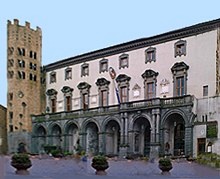
A commune was in existence in Orvieto by 1137, but its members probably swore allegiance to the bishop. In 1157, Pope Hadrian IV visited the city and recognised its self-governing status within the papal patrimony. The secular representatives of the city at this time were two nobles and two consuls: these latter two officials seem to have represented the merchant class. A Podestà is recorded at Orvieto in 1177, 1181 and 1196. Consular government gave way to papal control in 1198-1203, but is documented again in 1210-15. It reappeared intermittently after that until 1242, after which it gave way to a Podestà.
Important civic occasions were held in front of the church of Sant’ Andrea (in Piazza di Sant’ Andrea) during the 12th century. These included the earliest documented submission to the Commune by one of the local nobles: Count Ranieri di Montoro who owned lands near Bolsena, made his submission here in 1168. What was probably the first civic palace of Orvieto was built next to Sant’ Andrea in 1216-9.
This palace was destroyed in a fire and rebuilt in 1255-76. The new building had a loggia of seven arches on the ground floor. A series of rooms above that had wooden ceilings supported by transverse arches. A street that passed through the central arch linked Piazza di Sant’ Andrea to Porta Pertusa (later Porta Romana). The civic fountain was built in the piazza in 1276.
Traces of the 13th century palace and its decoration survive:
-
✴Some architectural fragments can be seen embedded in the external walls at the back of the present structure.
-
✴The original vaulting and some of the original transverse arches survive in the largest room on the first floor, which was probably the Sala del Consiglio.
-
✴Traces of the frescoes (1345-7) that were executed when Matteo Orsini took control of the city can be seen in a room on the second floor that today houses the Archivio Storico (city archives).
By 1485, this palace was in such a poor state or repair that the Council held its meetings in the Palazzo Vescovile, a practice that continued until 1580.
The collapse of the adjacent Torre Comunale (later the campanile of Sant’ Andrea) in 1515 led to the decision to rebuild the palace.
-
✴Michele Sanmicheli was commissioned to provide a design in 1515, but no trace of this survives.
-
✴Antonio da Sangallo il Giovane was commissioned to provide a model in 1532.
However, no substantial progress was made.
Present Palace (1573-81)
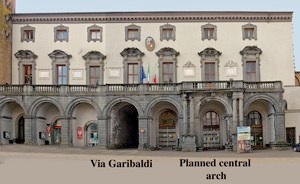
The project received new life in 1563, when the loggia of the palace facing Sant' Andrea had to be demolished because it threatened to collapse. In 1573, Ippolito Scalza was finally commissioned to rebuild the palace according to the design by Antonio da Sangallo the Younger. In fact, his design, which survive in the Museo dell' Opera del Duomo, seems to have been very much his own.
Ippolito Scalza intended to re-use the existing fabric of the palace and to extend it, so that the ground floor loggia would comprise the seven original arches and four more to the right. Work duly started in 1573, but it was abandoned in 1581, before the extension had begun. This change of plan is obvious from the current appearance of the facade: the second arch from the right, which is distinguished by double columns, was obviously meant to be the central portal of the palace. The present Via Garibaldi, which was almost certainly intended to be diverted to pass through this arch, in fact still passes through the original central arch, two arches to the left of it.
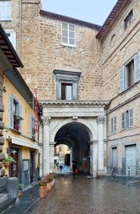
[Three of the windows at street level and all seven on the upper level of the facade were not built until 1889-9, as part of Paolo Zampi's restoration of the palace.]
Interior
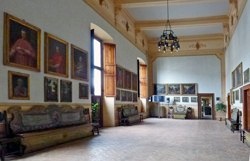
Take the lift at the far right of the palace to the second floor to see the main meeting rooms.
Gualterio Collection
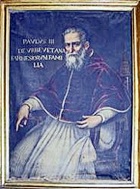
[Inscription (1725)
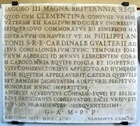
[Where is this now ??]
Art from the Palace
Crucifix (ca. 1400)
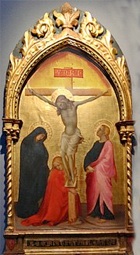
The frame, which seems to be largely original, nevertheless has an inscription that is more appropriate for an Annunciation: "Ave Maria Gratia Plena". The devices of an eagle and a lion to the sides symbolise the Commune.

